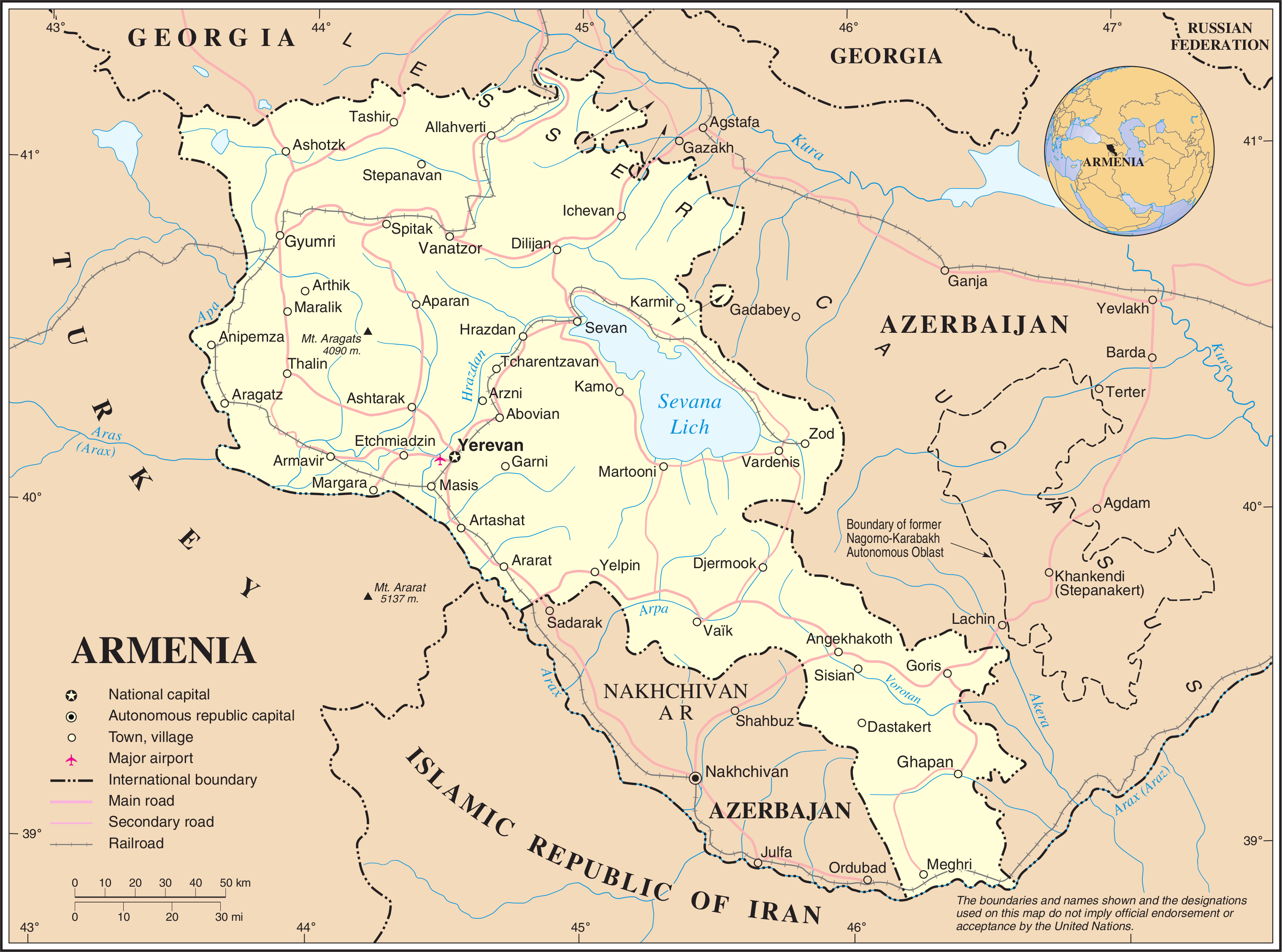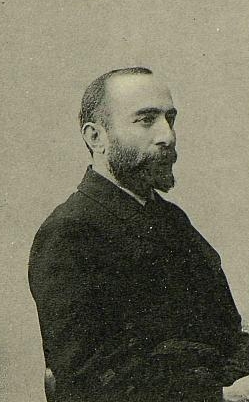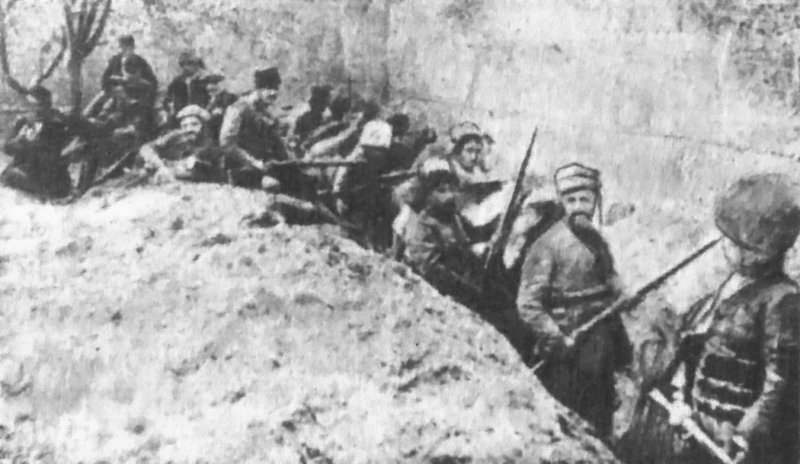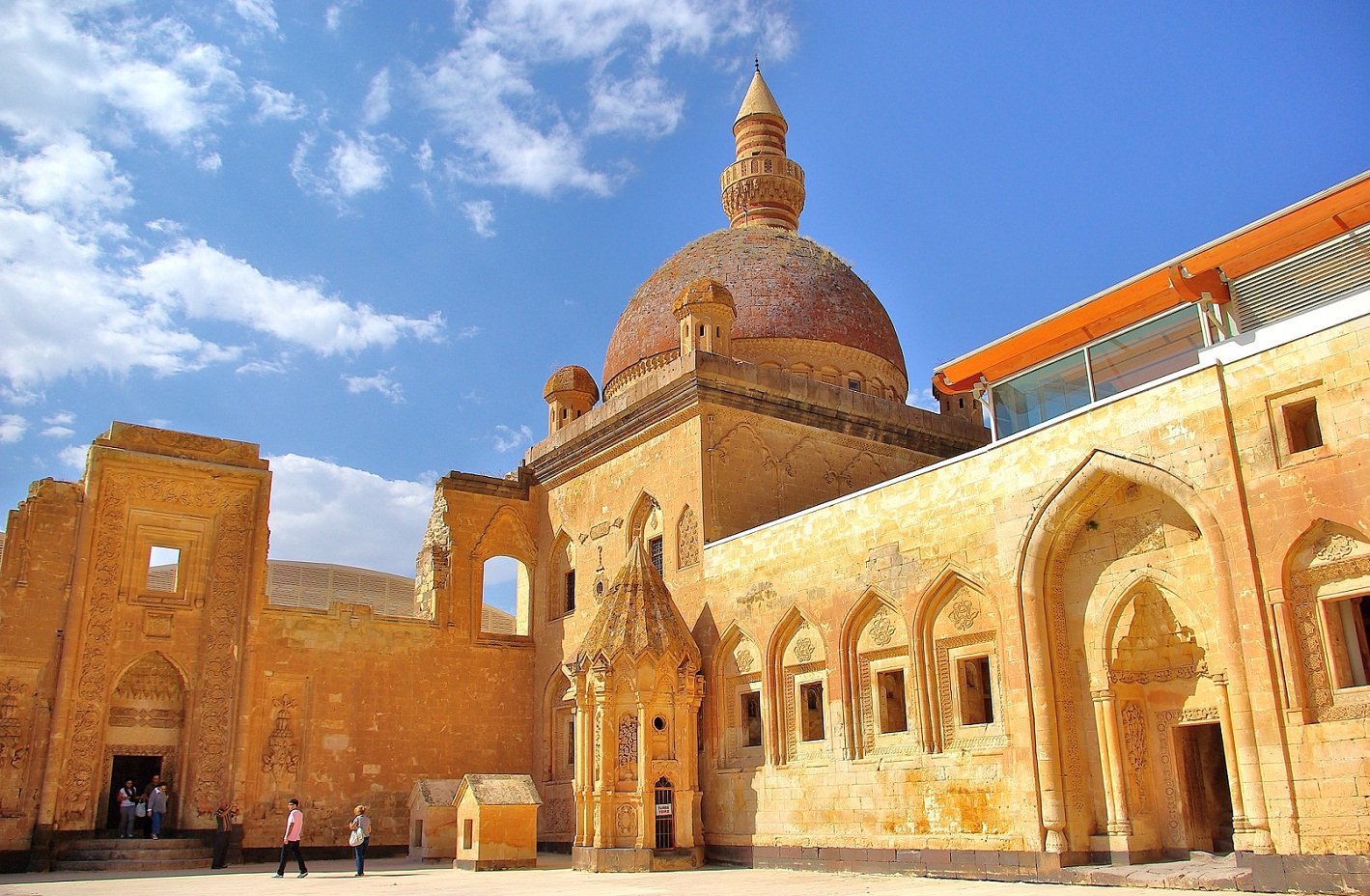|
Armenia–Turkey Border
The Armenia–Turkey border ( hy, Հայաստան–Թուրքիա սահման, translit=Hayastan–T’urk’ia sahman, tr, Ermenistan–Türkiye sınırı) is 311 km (193 m) in length and runs from the tripoint with Georgia (country), Georgia in the north to the tripoint with Azerbaijan in the south. The land border has been closed since April 3rd, 1993. Description The border starts in the north at the tripoint with Georgia just west of Lake Arpi and proceeds southwards via series of irregular lines through the Armenian Highlands. Upon reaching the Akhurian River it follows the river south down to the confluence with the Aras river, and then follows the Aras as it flows east and then south-east, down to the tripoint with Azerbaijan's Nakhchivan Autonomous Republic. The ancient ruins of Ani lie directly adjacent to the border on the Turkish side. History During the 19th century, the Caucasus region was contested between the declining Ottoman Empire, Qajar Iran, Persia ... [...More Info...] [...Related Items...] OR: [Wikipedia] [Google] [Baidu] |
Russo-Turkish War (1877–1878)
The Russo-Turkish War of 1877–1878 ( tr, 93 Harbi, lit=War of ’93, named for the year 1293 in the Islamic calendar; russian: Русско-турецкая война, Russko-turetskaya voyna, "Russian–Turkish war") was a conflict between the Ottoman Empire and a coalition led by the Russian Empire, and including Bulgaria, Romania, Serbia, and Montenegro. Fought in the Balkans and in the Caucasus, it originated in emerging 19th century Balkan nationalism. Additional factors included the Russian goals of recovering territorial losses endured during the Crimean War of 1853–56, re-establishing itself in the Black Sea and supporting the political movement attempting to free Balkan nations from the Ottoman Empire. The Russian-led coalition won the war, pushing the Ottomans back all the way to the gates of Constantinople, leading to the intervention of the western European great powers. As a result, Russia succeeded in claiming provinces in the Caucasus, namely Kars and Batum, a ... [...More Info...] [...Related Items...] OR: [Wikipedia] [Google] [Baidu] |
Trebizond Peace Conference
The Trebizond Peace Conference was a conference held between 14 March and 13 April 1918 in Trebizond between the Ottoman Empire and a delegation of the Transcaucasian Diet ( Transcaucasian Seim) and government. The opening session was on 14 March 1918. The representatives were Rear-Admiral Hüseyin Rauf Bey for the Ottoman Empire, and Akaki Chkhenkeli, Khalil bey Khasmammadov, Alexander Khatisian etc. as the Transcaucasian delegation. The Armistice of Erzincan signed by the Russian and Ottomans in Erzincan on December 5, 1917, ended the armed conflicts between Russia and Ottoman Empire in the Persian Campaign and Caucasus Campaign of the Middle Eastern theatre of World War I.Tadeusz Swietochowski, ''Russian Azerbaijan 1905-1920'', page 119 The armistice was followed by the Treaty of Brest-Litovsk on March 3, 1918, between the Russian SFSR and the Central Powers, marking Russia's exit from World War I. The Ottoman Empire and the Transcaucasian Democratic Federative Republic conf ... [...More Info...] [...Related Items...] OR: [Wikipedia] [Google] [Baidu] |
Transcaucasian Democratic Federative Republic
The Transcaucasian Democratic Federative Republic (TDFR; (), (). 22 April – 28 May 1918) was a short-lived state in the Caucasus that included most of the territory of the present-day Armenia, Azerbaijan and Georgia, as well as parts of Russia and Turkey. The state lasted only for a month before Georgia declared independence, followed shortly after by Armenia and Azerbaijan. The region that formed the TDFR had been part of the Russian Empire. As the empire dissolved during the 1917 February Revolution and a provisional government took over, a similar body, called the Special Transcaucasian Committee (Ozakom), did the same in the Caucasus. After the October Revolution and rise of the Bolsheviks in Russia, the Transcaucasian Commissariat replaced the Ozakom. In March 1918, as the First World War continued, the Commissariat initiated peace talks with the Ottoman Empire, which had invaded the region, but that broke down quickly as the Ottomans refused to accept ... [...More Info...] [...Related Items...] OR: [Wikipedia] [Google] [Baidu] |
Treaty Of Brest-Litovsk
The Treaty of Brest-Litovsk (also known as the Treaty of Brest in Russia) was a separate peace, separate peace treaty signed on 3 March 1918 between Russian SFSR, Russia and the Central Powers (German Empire, Germany, Austria-Hungary, Kingdom of Bulgaria, Bulgaria, and the Ottoman Empire), that ended Eastern Front (World War I), Russia's participation in World War I. The treaty was signed at German-controlled Brest-Litovsk ( pl, Brześć Litewski; since 1945, Brest, Belarus, Brest, now in modern Belarus), after two months of negotiations. The treaty was agreed upon by the Russians to stop further invasion. As a result of the treaty, Soviet Russia defaulted on all of Imperial Russia's commitments to the Allies of World War I, Allies and eleven nations became independent in eastern Europe and western Asia. Under the treaty, Russia lost all of Ukrainian People's Republic, Ukraine and most of Belarusian People's Republic, Belarus, as well as its three Baltic states, Baltic republics of ... [...More Info...] [...Related Items...] OR: [Wikipedia] [Google] [Baidu] |
1917 Russian Revolution
The Russian Revolution was a period of political and social revolution that took place in the former Russian Empire which began during the First World War. This period saw Russia abolish its monarchy and adopt a socialist form of government following two successive revolutions and a bloody civil war. The Russian Revolution can also be seen as the precursor for the other European revolutions that occurred during or in the aftermath of WWI, such as the German Revolution of 1918. The Russian Revolution was inaugurated with the February Revolution in 1917. This first revolt focused in and around the then-capital Petrograd (now Saint Petersburg). After major military losses during the war, the Russian Army had begun to mutiny. Army leaders and high ranking officials were convinced that if Tsar Nicholas II abdicated, the domestic unrest would subside. Nicholas agreed and stepped down, ushering in a new government led by the Russian Duma (parliament) which became the Russian Provis ... [...More Info...] [...Related Items...] OR: [Wikipedia] [Google] [Baidu] |
Caucasus Campaign
The Caucasus campaign comprised armed conflicts between the Russian Empire and the Ottoman Empire, later including Armenia, Azerbaijan, Georgia, the Mountainous Republic of the Northern Caucasus, the German Empire, the Central Caspian Dictatorship, and the British Empire, as part of the Middle Eastern theatre during World War I. The Caucasus campaign extended from the South Caucasus to the Armenian Highlands region, reaching as far as Trabzon, Bitlis, Mush and Van. The land warfare was accompanied by naval engagements in the Black Sea. The Russian military campaign started on 1 November 1914 with the Russian invasion of Turkish Armenia. In February 1917, the Russian advance was halted following the Russian Revolution. The Russian Caucasus Army soon disintegrated and was replaced by the forces of the newly established Armenian state, comprising Armenian volunteer units and irregular units which had previously been part of the Russian Army. During 1918 the region also s ... [...More Info...] [...Related Items...] OR: [Wikipedia] [Google] [Baidu] |
First World War
World War I (28 July 1914 11 November 1918), often abbreviated as WWI, was one of the deadliest global conflicts in history. Belligerents included much of Europe, the Russian Empire, the United States, and the Ottoman Empire, with fighting occurring throughout Europe, the Middle East, Africa, the Pacific, and parts of Asia. An estimated 9 million soldiers were killed in combat, plus another 23 million wounded, while 5 million civilians died as a result of military action, hunger, and disease. Millions more died in genocides within the Ottoman Empire and in the 1918 influenza pandemic, which was exacerbated by the movement of combatants during the war. Prior to 1914, the European great powers were divided between the Triple Entente (comprising France, Russia, and Britain) and the Triple Alliance (containing Germany, Austria-Hungary, and Italy). Tensions in the Balkans came to a head on 28 June 1914, following the assassination of Archduke Franz Ferdina ... [...More Info...] [...Related Items...] OR: [Wikipedia] [Google] [Baidu] |
Eleşkirt
Eleşkirt ( ku, Zêdikan) is a town and district of Ağrı Province in Turkey. Its name is a transference from Alashkert ( hy, Ալաշկերտ, translit=Alaškert), the valley's former administrative centre but now a village known as Toprakkale. It was known as ''Vagharshakert'' in medieval sources. At the time of the Russo-Turkish War of 1877-1878 approximately half of the population consisted of Armenians and the rest of Kurds and Turks. The mayor is Ramazan Yakut (Felicity Party). Notable people *Şakiro Şakir Deniz also known as Şakiro (born in 1936 in Eleşkirt–1996, Izmir, Turkey), was a Kurdish Dengbêj singer. His songs were often recorded on cassettes and distributed illegally, when the Kurdish language faced limitations in cultural expr ... References Populated places in Ağrı Province Ski areas and resorts in Turkey Districts of Ağrı Province Kurdish settlements in Turkey {{Ağrı-geo-stub ... [...More Info...] [...Related Items...] OR: [Wikipedia] [Google] [Baidu] |
Doğubayazıt
Doğubayazıt ( ku, Bazîd, ) is a district of Ağrı Province of Turkey, and it is the easternmost district of Turkey, lying near the border with Iran. Its elevation is 1625m and its area is 2,383 km². Doğubayazıt's population in 2010 was 115,354 (up from 73,794 in 1980) of which 69,447 live in the town of Doğubayazıt, the remainder in the surrounding countryside. Also known as ''Kurdava'', the town was the capital of the self-declared Republic of Ararat, an independent Kurdish state centered in the Ağrı Province.Abbas Vali, ''Essays on the origins of Kurdish nationalism'', Mazda Publishers, 2003, p. 199./ref> History For most of the periods described here, Doğubayazıt was a bigger and more important settlement than the present-day provincial capital ''Ağrı'', not least because this is the Iranian border crossing. The area has had a rich history with monuments dating back to the time of the Kingdom of Urartu (over 2700 years ago). Before the Ottoman Empire the site ... [...More Info...] [...Related Items...] OR: [Wikipedia] [Google] [Baidu] |
Treaty Of Berlin (1878)
The Treaty of Berlin (formally the Treaty between Austria-Hungary, France, Germany, Great Britain and Ireland, Italy, Russia, and the Ottoman Empire for the Settlement of Affairs in the East) was signed on 13 July 1878. In the aftermath of the Russian victory against the Ottoman Empire in the Russo-Turkish War of 1877–1878, the major powers restructured the map of the Balkan region. They reversed some of the extreme gains claimed by Russia in the preliminary Treaty of San Stefano, but the Ottomans lost their major holdings in Europe. It was one of three major peace agreements in the period after the 1815 Congress of Vienna. It was the final act of the Congress of Berlin (13 June – 13 July 1878) and included Great Britain and Ireland, Austria-Hungary, France, Germany, Italy, Russia and the Ottoman Empire. Chancellor of Germany Otto von Bismarck was the chairman and dominant personality. The most important task of the Congress was to decide the fate of Bulgaria, but Bulgaria ... [...More Info...] [...Related Items...] OR: [Wikipedia] [Google] [Baidu] |
Ardahan
Ardahan (, ka, არტაანი, tr, hy, Արդահան, translit=Ardahan Russian: Ардаган) is a city in northeastern Turkey, near the Georgian border. It is the capital of Ardahan Province. History Ancient and medieval Ardahan was historically located in the region of Gogarene (Gugark), which Strabo calls a part of the Armenia that was taken away from the Kingdom of Iberia. "Ardahan," Armenian Soviet Encyclopedia. Yerevan: Armenian Academy of Sciences, 1976, vol. 2, p. 7. In the Middle Ages Ardahan served as an important transit point for goods arriving from the Abbasid Caliphate and departing to the regions around the Black Sea. During the 8th to 10th centuries the region was in hands of the Bagrationi princes of Tao-Klarjeti under the name of Artaani, and later part of Kingdom of Georgia between 11th to 15th centuries. According to the Arab historian Yahya of Antioch, the Byzantines razed Ardahan and slaughtered its population in 1021. The Mongols took hold ... [...More Info...] [...Related Items...] OR: [Wikipedia] [Google] [Baidu] |



.jpg)



